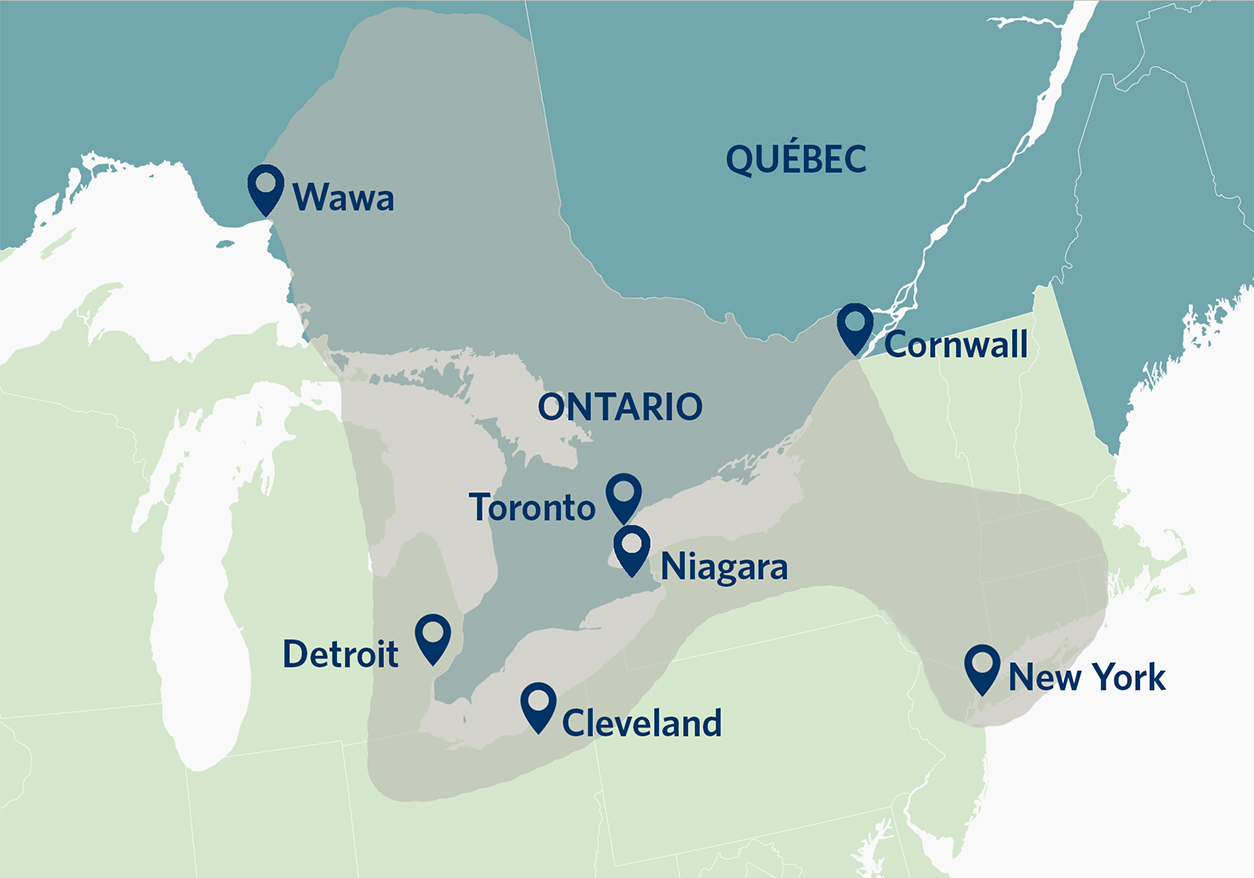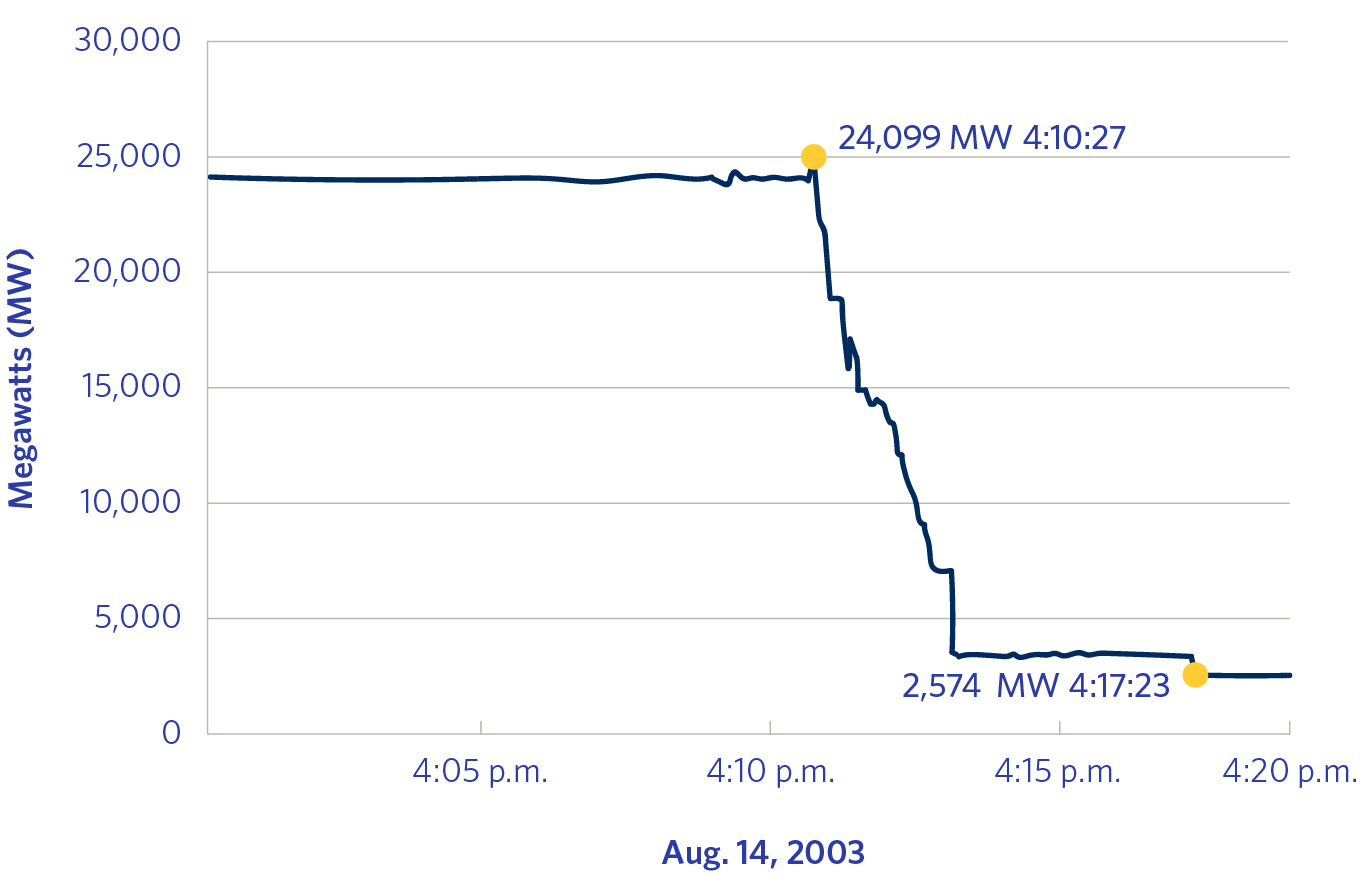Looking Back at Blackout 2003
What Happened?
More than 50 million people in Ontario and the northeastern United States experienced the largest power outage in the history of North America on August 14, 2003. This page looks back at what caused the power outage, presents lessons learned and outlines some of the steps that have been taken since to improve power system reliability across North America.
Sequence of Events

The causes for the blackout are attributed to deficiencies in operations and procedures in the state of Ohio. Specifically, there was a lack of adequate vegetation, or tree, management, poor communications between various utilities in the area, compounded by lack of training and tools for local operators to effectively deal with the emergency.
Due to these degraded conditions in Ohio, a series of large power swings ranging between 2,000 and 4,000 megawatts pulsed through New York and Ontario and into Michigan, overloading the system.
As a result, at 4:11 p.m. on August 14, the northeastern United States power system, and portions of the Ontario power system began to shut down. Roughly 61,800 megawatts of customer load was interrupted, which impacted a population of more than 50 million people. In Ontario, nearly all electricity service east of Wawa was down, with small pockets of electricity service remaining.
Protective equipment was able to separate the transmission system at Wawa and maintain electricity service in the northwest. In Cornwall, power continued to flow from Quebec—whose electricity system operates separately from the eastern North American grid—through dedicated power lines and a local hydroelectric dam. The system was also able to isolate itself in the Niagara area, with the Sir Adam Beck Hydroelectric generation station serving customers in Ontario and New York and playing a critical role in re-energizing the system.
While Ontario’s power system was restored within 30 hours, a state of emergency was in effect until August 22 while the province’s generation fleet was brought back to full production capability.
System Restoration

The IESO directed the restoration of the Ontario grid as part of a co-operative effort with transmitters, generators and local distribution companies (LDCs). Restoration is a complex process, which starts with determining the extent of the disturbance, establishing restoration priorities, coordinating operations, and balancing generation and demand while maintaining frequency and voltage. The 2003 blackout tested emergency procedures and training for the entire industry − and required everyone, including consumers to work together to bring power back online to the province safely and quickly.
The first stage was to bring generators back in service. Many had been forced to shut down − or could not run for extended periods or restart without power supply from the grid. The next stage was to restore power to the remaining high voltage transmission lines and critical consumers. Stage three was the restoration of power to LDCs and other power users, who could then restore power within their respective distribution areas.
For the remainder of the initial week, restoration work continued and the IESO issued daily public appeals to reduce energy consumption as generators throughout the province returned to service. Conservation was critical during this period with homeowners and businesses reducing peak demand by 15 to 20 per cent each day. This public appeal was lifted at 8:00 p.m. on Friday, August 22 when the province's generation fleet was finally restored to its normal production capabilities.
Read about the 2003 blackout from the perspective of an IESO control room operator.
Reliability: Then and Now
Before the blackout, mandatory reliability standards only existed in Ontario. After the blackout, a Canada-U.S. Task Force was formed to identify the causes of the power outage and seek recommendations to help prevent future outages.
Their final report identified 46 specific technical and policy recommendations on minimizing or preventing future blackouts; the top recommendation stressed the creation of mandatory reliability standards and enforceability with penalties for non-compliance. As a result, today there are standards throughout North America setting out clear roles and responsibilities for system and transmission operators that are monitored and enforced, thus improving the resiliency of the interconnected network.
The recognized standards authorities, the North American Electric Reliability Corporation (NERC) and the Northeast Power Co-ordinating Council (NPCC), define the reliability requirements for planning and operating the interconnected North American bulk electric system.
Reliability policies also require all the interconnected jurisdictions to formally share their experiences to create a continuous learning process for all power system operators. The interconnected power system today is more accountable and works to a higher standard as a result.
The IESO works with its partners to plan and prepare for the unexpected. Ontario faces a number of challenges to system resiliency, including extreme weather events, threats to physical security and cyber attacks. All three elements are part of a changing dynamic where "high-impact, low-frequency" events are now routinely considered as part of system contingency planning and are critical to ensuring future reliability.
 Credit: Vince Talotta/GetStock.com
Credit: Vince Talotta/GetStock.com
The IESO is the Reliability Co-ordinator for Ontario. In this role, it is responsible for the reliable operation of the Ontario’s bulk power grid in compliance with North American and provincial grid standards, which includes taking steps to prevent or mitigate system emergencies. It also leads system restorations following major events on the high-voltage grid.
Each year, the IESO conducts numerous emergency simulations and training sessions to ensure that grid operators and partners have the skills, tools and capabilities to manage system events. By learning from past events and forward-looking analyses, it refines policies, processes, and tools to minimize potential risks to the grid under stressed operating conditions. Managing events also requires close co-ordination with the sector through continuous dialogue, training, and awareness.
The IESO also plans the system to ensure that there are sufficient redundancies and supply cushions to mitigate potential problems on the transmission system or at generation facilities.
Canada-U.S. Task Force's final report on the August 2003 Blackout
